

ISTE 2015: Takeaway Tips for a Library Maker Space. Maker station at the ISTE Librarians Digital Age Playground at the 2015 ISTE conference in Philadelphia.

The maker movement was front and center at the 2015 ISTE conference—and that’s a good thing for me. Small Tech, Big Impact: Designing My Maker Space. Teens tinker with littleBits at the Public Library of Mount Vernon and Knox County, OH.Photography by George C.
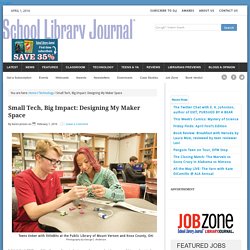
Anderson I didn’t think 2015 would be the year I created a teen maker space, but it was—and it turned out to be an exciting, challenging, and rewarding experience. After six months of planning, our maker space at the Public Library of Mount Vernon and Knox County, Ohio, where I am the YA services coordinator, opened last month. How did it come together? Organically. We started planning anyway. Jensen (left) with students using the button maker. Start small Our first challenge was space. The Maker Issue. 2nd Ed MakerED Resources For School Makerspaces EBOOK 3 14 16.
How to Run an AWESOME After-school Makers Club. Maker Education and Social-Emotional Development. Planning educational activities that incorporate social-emotional learning has broad benefits.

The Joy of the Maker Movement. Resources MakerEd.org A nonprofit online community devoted to making, providing custom training and support to teachers, workshops, and a free library of project ideas, program strategies, makerspaces, and tools.
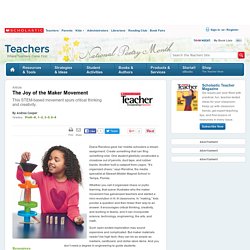
Colleengraves.org Creative making lessons and resources. Graves is one of many maker teachers and consultants who share ideas on their blogs. Make A leading resource for makers, each issue features step-by-step projects using ordinary household materials. Makerspaces Lead to School and Community Successes. While the Maker Movement continues to grow, it hasn't yet gained its greatest traction, which currently sits untapped in the minds of the students in front of us.
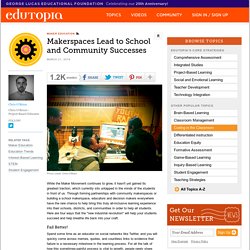
Through forming partnerships with community makerspaces or building a school makerspace, educators and decision makers everywhere have the rare chance to help bring this truly all-inclusive learning experience into their schools, districts, and communities in order to help all students. Here are four ways that the "new industrial revolution" will help your students succeed and help breathe life back into your craft. Fail Better! Spend some time as an educator on social networks like Twitter, and you will quickly come across memes, quotes, and countless links to evidence that failure is a necessary milestone in the learning process.
For all the talk of how this sometimes-painful process is vital to growth, people rarely share examples of how to facilitate room for healthy failure in the classroom. Bridging The Gap. Thinking of Building a Makerspace? Think Again! Ok, so the title of the post may have led you to think that I believe makerspaces aren’t a good thing.

But that couldn’t be further from the truth. For the past 10 years, I’ve been working in — or designing professional learning for supporting — PBL/maker programs, so I have absolutely drank the kool-aid. I just want us to think deeper than the shiny, sparkly surface. So let’s think again! Nearly every day I’m approached with questions about how to start a makerspace. Makerspace Resources and Programming ideas. (Updated post from my Podbean Site) Summer 2014 I was asked to present a webinar to Ohio School Librarians for InfOhio.
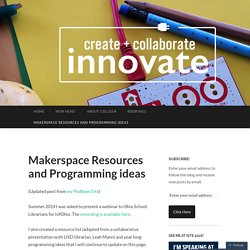
The recording is available here. I also created a resource list (adapted from a collaborative presentation with LISD librarian, Leah Mann) and year long programming ideas that I will continue to update on this page. WEBINAR RECORDING: Creativity is... #winnipegSDITLL #winnipegsd #creativity #edchat #4Cs #makerspace. Create a school makerspace in 3 simple steps. As maker education gains steam, many educators are looking for ways to incorporate making and tinkering into their schools and classrooms — often on a shoestring budget. “Kids are saying they want to learn more about technology and science, but they also want to experience it creatively and use it personally,” said Dale Dougherty, founder of Make Media, which produces Maker Faire and Make Magazine.
He’ll address how educators can deliver these types of experimental learning experiences during ISTE 2014’s EdTekTalks, a provocative series of mini-keynotes from thought leaders beyond the world of ed tech. “One of the ways we can do that is create more makerspaces for kids. Part of my talk will be leading the charge to say let’s build more makerspaces inside schools, libraries and even community centers.” But what makes a makerspace? Makerspaces can be elaborate learning spaces equipped with sophisticated tools and supplies, but they don’t have to be.
Step 1: Secure some space. Why the 'Maker Movement' is Popular in Schools. The maker movement is a global, DIY movement of people who take charge of their lives, solve their own problems and share how they solved them.
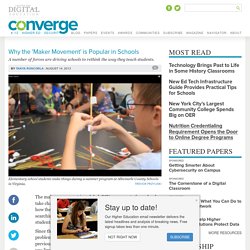
And it's growing in schools that are searching for more authentic learning experiences for their students. Since the beginning of time, people have made things to solve problems and otherwise improve their quality of life. But previously, the amount of exposure individual projects received was limited. Now the Internet has driven projects into the limelight. "These things that used to be isolated are now shared widely," said Sylvia Libow Martinez, president of nonprofit education technology organization Generation YES and co-author of the book Invent to Learn. She shared an example of how this global movement works. The Maker Movement and the Humanities: Giving Students A Larger Toolbox. Co-Authored by John Rieffel, Assistant Professor of Computer Science at Union College, NY The empowering rise of the do-it-yourself Maker Movement has found fertile ground in higher education, cultivating a vibrant community who believe in the effectiveness of learning through doing, sharing and mentoring, playing, exploring, and risk-taking.

As exemplified by Case Western Reserve University’s impressive Think [box] Center for Innovation, academic Makerspaces provide participatory contexts for hands-on, fun and collaborative learning that are a refreshing alternative—albeit no substitute—to “sage on the stage” lectures.